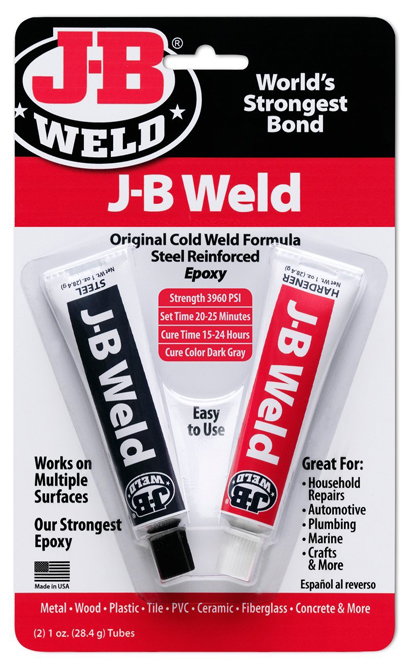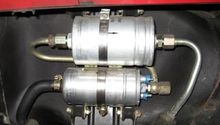Porsche 928: How to Fix a Leaking Gas Tank
Gas is pricey, but it's also highly flammable. Make sure your Porsche 928 is keeping its gas in the tank, not on the ground.
This article applies to the Porsche 928 (1979-1995).
As gearheads and car enthusiasts, we all love the smell of fuel. For many, that sweet smell brings back great memories of many miles on the road. But when we can smell it at times we are not supposed to, this usually means something is wrong. The worst part about it is that it could possibly mean that money is being wasted with every drop that gets out before it can be burned.

Materials Needed
- Epoxy
- Piece of fuel-resistant material
The first thing you are going to want to do, if you determine that you have a leaking fuel tank, is pinpoint where the leak is coming from. A fuel tank on a fuel-injected vehicle is a bit more complex than a tank with a filler opening and a supply line. There are vent lines, fuel return lines, plus a few o-rings and seals that are part of the fuel tank assembly. It is completely possible, considering the age of Porsche 928s, that an o-ring needs to be replaced, or one of the many rubber lines that is part of the whole assembly.
The easiest way to determine where the leak is coming from is to position the car so you can see the tank and all of its components. Due to the car's age the tank will be a few shades lighter black than it was when new. What you want to be looking for is any spot where it is significantly darker than the rest of the tank. Of course, this will differ depending on the severity of your leak. If you have a major leak you will probably be able to see the dripping or running fuel from it. But if you have a minor leak, it will be more of a seeping and thus more difficult to see.
After you have determined where the leak is coming from, you can then put together a plan of action and determine what parts you are going to need. There are still many parts places out there that carry all of the seals and o-rings that are part of the fuel tank assembly. Let's say that your leak is coming from the actual body of the fuel tank. Maybe it got punctured or somehow developed a hole and fuel is leaking from it. This is probably the more difficult kind of leak to fix. Most professional mechanics out there will probably say that you have to replace the entire fuel tank. While this is the proper repair for this problem, replacement 928 fuel tanks are not necessarily easy to get or very cheap, so this might not be an option for you.
Then the question arises. Can you fix a leak in the body of a fuel tank without having to replace the tank? The answer is yes you can. Is it the best way to fix it? No. The best way is to replace the entire tank, but again this might not be possible for you, or you might be in the middle of nowhere on a road trip and this is your only option. Here's a brief run though of how to repair a leaking tank on your 928.
Step 1 – Determine the type of epoxy you will need
Epoxy is not all made the same. You have many different types for different applications. What you are looking for is one that can bond to plastic or ABS and is chemical and, more importantly, fuel-resistant. It would do you no good to use an epoxy that your fuel will just eat through.
Most general auto parts stores and hardware stores carry various different kinds of epoxy. All of them will list on the back or front of the package what they are designed to be used for.

Step 2 – Drain the tank or position car so fuel is away from leak
Before starting your repair, you need to somehow move the fuel away from the hole or point of leaking. The epoxy you are using will never bond if fuel keeps touching it.
There are a few ways you could do this. If it's possible, drain excess fuel out of the car until the fuel level is below the leak. If this isn't possible, then you can always jack the car up on one side and position the car so the fuel moves away from the leak. Obviously each situation and leak will require a different method and a little bit of creativity.
(Related Article: How to Jack Up a 928 - Rennlist.com)

Step 3 – Prepare area of fuel tank where epoxy will be applied
Before applying the epoxy, you must first prepare the area where you are going to apply it. If is wet with fuel around that area, you are going to first want to either wait for the fuel to evaporate or somehow wipe it clean. Fuel evaporates pretty quickly so you can even do both. Once the area is dry, you are going to want to scuff it up just a little bit so it's not smooth. The epoxy will bond better to a coarser surface. You don't have to go crazy, just enough scuffing to change the surface.
Step 4 – Make patch for hole
In order to ensure the effectiveness of your repair, it will be best to make a patch that will cover the hole where the leak is coming from. You will want to make it out of a similar material to what the tank is made out of. If this is not possible, then at least make it out of a fuel-resistant material. You don't want to make it too big, just enough to cover the hole.
Pro Tip
Some owners have used pieces of plastic kitchen cutting boards (HDPE) to melt into place to cover the hole.

Step 5 – Apply epoxy
After you have made your patch, you can apply your epoxy. Every epoxy will have a different method of application. Make sure you fully read and understand how that epoxy manufacturer wants you to apply it. This is extremely important for the effectiveness of your epoxy repair. Any epoxy can only do what it is designed to do if it is applied correctly.

Step 6 – Monitor your repair
After you have applied your epoxy and let it cure, you should be good to put the fuel back in the tank. Keep an eye on the repair spot. If you failed to do it correctly, you will know. If you are doing this repair because you had to do it to get back home, pull over every so often and check to see if it is still holding fuel. Fuel leaks can turn into major problems very quickly.
Related Discussions
- Porsche 928 Fuel Tank Repair - Rennlist.com
- Leak After Fill Up - Rennlist.com
- Shroud Repair Question about Plastic Pieces - Rennlist.com






